Original URL: https://www.theregister.com/2007/10/27/robo_developer_show_floor_pictures_2/
Robo Developer Conference in pictures II
Hi! Robot
Posted in Science, 27th October 2007 00:41 GMT
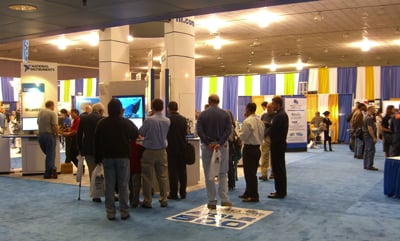
Welcome to our second look at the Robo Developer conference in sunny San Jose. We've got even more mechanical freaks to share this round.
Our first booth today is Willow Garage, which is a privately-funded research lab selling their gear as a "standardized robotics platform" for domestic robots.
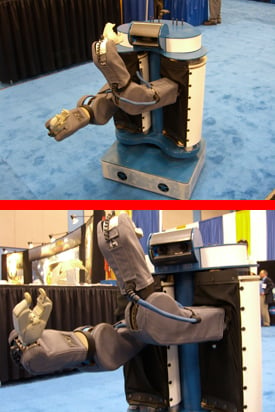
The bot here is a prototype of the hardware and software they'll be selling. The idea is that the robot is completely modular, so if a buyer wants to put a different arm on the device, it's easily done. If they want to try putting legs on it, well good luck to you.
Willow Garage was founded by Scott Hassan, one of the early Google architects and creator of eGroups, which sold to Yahoo! in 2000 for $412m. I'm told they aren't strained for cash.
Eventually they plan to use the design to build general purpose robots that can perform tasks such as cleaning rooms, serving food and even opening a beer. I swear to god they had a video of the thing opening a beer. My heart is melting.
Modular is hot right now in robotics. Academia, for instance often doesn't have the time or resources to start from square one every time they want to build a robot. So companies such as Schunk sell specific robot parts.
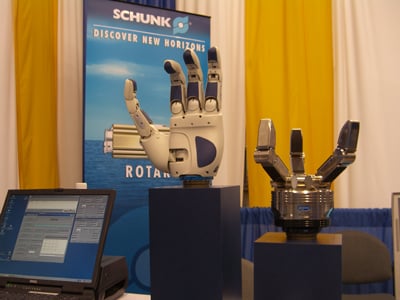
Hmm, do I go with the giant gorilla or Doctor Octopus look on my doomsday machine? Decisions, decisions.
The folks at Schunk (ok, let's pause to get it out of your system) — the folks at Schunk tell me they have customers ranging from robotic research, handling toxic waste and the prosthetics market as well.
A robot has also gotta have peepers. We've got facial recognition software at IntelliVision (not to be confused with the Intellivision video game console released by Mattel in 1979):
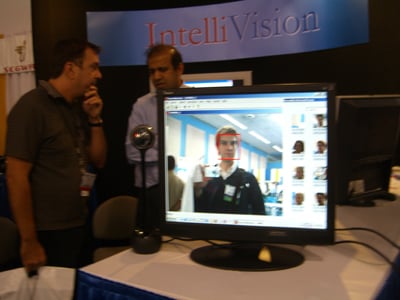
And a cheaper form of object recognition for toys and phones from Evolution Robotics.
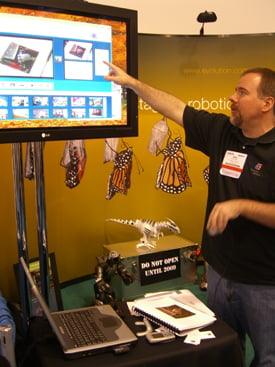
He's pointing a PC camera at a CD cover. The software recognizes various pixel points on an object to identify it. The technology is apparently already in use in Japanese cell phones. A user can point their picture phone at a piece of merchandise, and the software will check its data base to bring back relevant information.
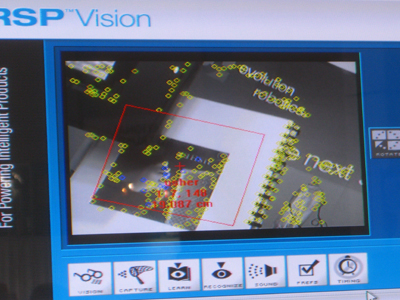
The technology will probably arrive in the US and Europe by means of WowWee toys, such as the Robosapien and Roboraptor seen in the previous image's background. Evolution Robotics announced it has made a deal with the toy company to put the visual technology in future toys. They claim it will give the robots the ability to — and I kid you not the CEO said this — chase children around the house.
Surely, the age of man draws near its close.
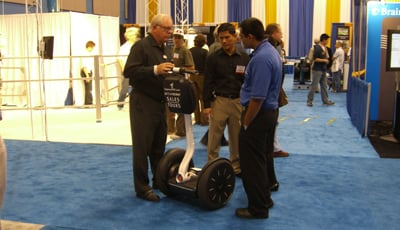
What? Segway is here? Aren't we stretching the definition of "robot" a little thin? Let's keep walking.
From CoroWare, there's the CoroBot (for which The Register gives permission to be confused with Coro, the Latin freestyle singer). The CoroBot is another example of a robot that's meant to be taken apart to suit the whims of the buyer.
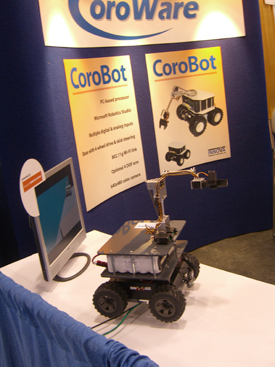
The bot is essentially a programmable mobile platform (as in a raised horizontal surface, not a software platform) with an optional crane claw. Another robot aimed at robotic researchers.
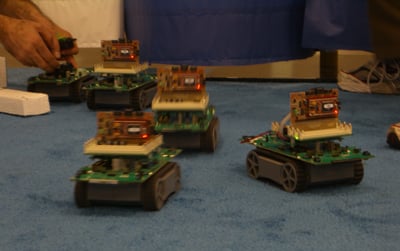
On the demo floor, there were little robots with "very simple programming" to avoid obstacles and hitting each other. Of course this meant they spent the majority of their time slamming into one another at full speed. Robots have excellent sense of comic timing when it comes to malfunctions.
As the show drew to a close, I got the terrible sensation that something was watching me.
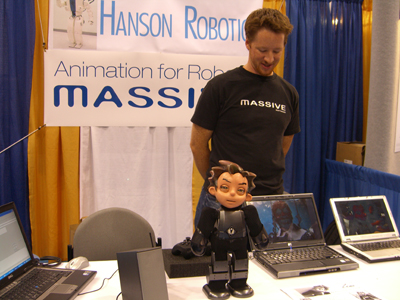
Now, just because something is a fraction of my size doesn't mean I'll just let it give me the stink-eye. In fact when it comes to confrontation I try to make certain they're a fraction of my size.
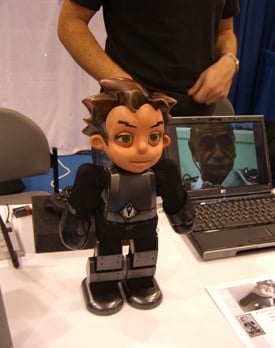
This 17" robot prototype is Zeno, a machine built by Hanson Robotics using technology from Massive Software. Massive is a developer of AI simulation software used in films such as the Lord of the Rings trilogy and Ratatouille</cite.
Zeno does the robo-navigation and responding to its physical environment thing — but can also make some impressive facial expressions with his rubbery little head.
Massive and Hansen can do some scary stuff. To the right of Zeno, you'll notice the face of Albert Einstein. That's not CG. That's a robot.
Let me show you why you should be terrified. Korean firm Kaist teamed with the two companies to make a robot that...
You'll just have to see the video. (YouTube warning.)
There's a popular hypothesis in robotics called "the uncanny valley," which was introduced by Japanese roboticist Mashahiro Mori in 1970. The hypothesis states that as robots (or other non-human entities) become more human-like in motion and appearance, they register as more appealing or empathetic to people.
For instance, a robot with a simple face is more visually appealing than a robo-crane on wheels. But only to a point. The uncanny valley is a theoretical drop-off point where the human facade reaches an extremely high level of realism — but still lacks all the subtle mannerisms, motion and details inherent of a true human being. The not-quite-human robot's flaws are then mentally highlighted, making it seem "off" and "creepy," like an animated corpse or body-snatcher.
The hypothesis continues that after a certain point, the empathy curve sweeps back up as the illusion of humanity is more successfully accomplished. Now while Einstein's head may well be leaving the valley, it still does so on the leathery wings of nightmares.
And now his grinning, yet oh-so sinister visage will visit you too whenever you close your eyes. Enjoy! ®